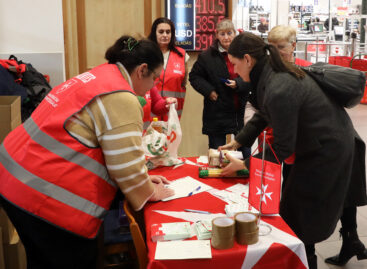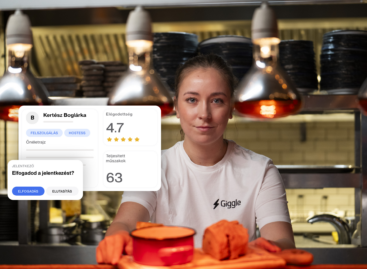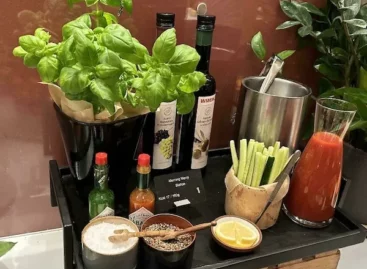Lunchtime
COVID-19 didn’t change the way we think: health trends keep influencing our diets just like before the virus scare, we are happy to try new dishes and love convenience food. Innovators aren’t affected by the virus either; the food industry is flooded with products based on the latest trends. Quitting meat is becoming trendy in Hungary as well.
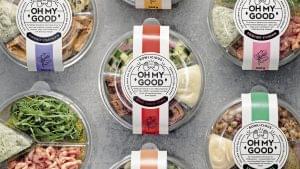
Office menu 2020 – healthy and varied lunch in attractive boxes – available in retail stores and on order
Menus and different strategies

Rudolf Semsei
owner
VakVarjú restaurants
According to Rudolf Semsei – the owner of VakVarjú restaurants, Bodza Bistro and Mákvirág restaurant – on weekdays one can have a lunch menu in a Budapest restaurant for HUF 1,200-1,300 and for HUF 1,000-1,200 in the countryside. This means two courses and typically the guests come from the nearby workplaces. From the menu’s price 60-70 percent is the VAT and the cost of ingredients and preparation, so the profit margin is about HUF 400 only.
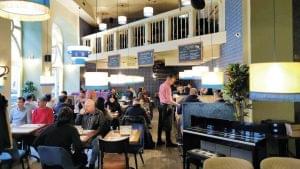
Offering lunch menus may only be profitable at places that attract also tourists by their look – the owner of VakVarjú restaurants believes
Rational decisions
Why do we serve lunch menus then? – Mr Semsei asked himself the question. For instance in downtown Budapest it looks good if a place is full, for instance it brings in foreign tourists. Typically the lunch menu is sold out already before 13.00 and those guests who pop in for a business lunch or to have something to eat with friends order food from the menu card, spending more.
Mr Semsei’s experience is that people are willing to walk about 7 minutes in lunchtime in districts where they can choose from more restaurants. He thinks it is a rather promising concept when there are 3 starters or soups, 3 main dishes and 2 desserts guests can choose from in a lunch menu.
Staying part of the future
Rudolf Semsei opines that reducing the VAT on delivered food to 5 percent is good news, but this step alone can’t solve the problems of classic restaurants, only makes the financial loss smaller. He thinks that after the pandemic the restaurant business will once again be an engine of the economy. However, owners will have to convince guests that they can feel save eating in a restaurant, because everything is clean and disinfected regularly – concluded the restaurant owner.
The first wave of the pandemic showed: they are unable to do the delivery work alone, therefore they had to partner with large networks. Debóra Blaumann, marketing director of NetPincér informed that more than 1,500 restaurants, cafés, grocery stores and confectioneries have joined forces with them since March. .
It is great to eat out, but now it’s time to stay at home

Debóra Blaumann
marketing director
NetPincér
Ms Blaumann said a large part of customers order for a smaller sum on weekdays, while weekend orders typically have a bigger basket value. In 2019 the average basket value was around HUF 3,500, this year it reached HUF 4,000. The company has introduced a contactless delivery system: when an order is placed, the customer can decide whether they want the food left at the door or garden gate or handed over. WHO and EFSA both stated this spring that food delivery is safe.
Today’s estimation is that 1.1-1.4 million people are eating food cooked in public sector catering. One of the problems for workplace cafeterias is that they are subject to a 27-percent VAT, while the restaurants on the street only have to pay a 5-percent VAT.

Home delivery services have also concluded contract with grocery stores
Public sector catering from the inside

Anna Zoltai
member of the presidency
KÖZSZÖV
Anna Zoltai, member of the presidency of the National Association of Public Sector Catering Service Providers (KÖZSZÖV) informed that mass catering is functioning, but workplace eating is in a crisis. Wage and ingredient costs are on the rise, so mass catering service providers are forced to cut costs by making compromises in cooking ingredient quality.
In those towns where the average income of people is higher, 3rd-4th grade students tend to opt for other lunch solutions than the school cafeterias. Mass catering companies say the first wave of the pandemic took all their savings, and they would need not only salary subsidies from the government, but also cutting the VAT from 27 percent to 5 percent.
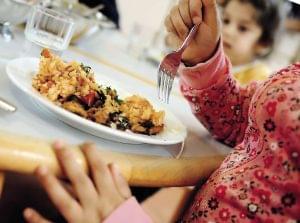
Children’s public catering mostly fails to comply with the principles of healthy eating
Step by step quality improvement
Representatives of the National Food Chain Safety Office (NÉBIH) talked to our magazine about the quality of food cooked in public sector catering. NÉBIH introduced a new and more objective 20-point testing and qualification system in 2017. In 2019 37 percent of the food was above average or excellent and 63 percent was average quality or worse.
Due to the pandemic situation, restaurants had no choice but to try and make some money by cooking for home delivery. NÉBIH reacted to this by testing delivered food as part of the Szupermenta programme. Their conclusion was that in most cases the restaurants where the food was cooked made sure that the packaging was safe; there was no risk for spreading the virus this way. //
The joys of convenience food

Gábor Steiner
sales manager
Foodbox
As the lifestyles of consumers are changing, ready meal sales are growing. Our products are made of natural ingredients only, they contain no preservatives and undergo heat treatment. The Foodbox FITT range targets health-conscious consumers. This year we rolled out chicken dishes in new tray packaging. Foodbox products can also be bought in our online shop. Thanks to their long shelf life, consumers can stock up for weeks in advance. //
Ready meals: Traditional, convenient and healthy

Márk Maczelka
head of communications
SPAR
Shoppers love typical Hungarian dishes, but we make sure to offer them healthy choices too: we serve salads, vegan and fitness meals as well. Let me mention that more and more convenience food products are made in the SPAR enjoy Convenience factory. We live in a world where everybody is always in a rush, therefore quality food which can be prepared quickly is becoming more important. //
Consumer needs, global brands and trends

István Bruzsa
sales manager
Nestlé
In addition to typical Hungarian dishes, consumers are becoming more interested in trying new, possibly healthy food too. Demand has increased for cream soups both at home and in mass catering, for which Maggi and CHEF bases are perfect choices. Main dishes can be made more exciting with the help of CHEF liquid products and CHEF and THOMY sauces. In January Nestlé Professional will roll out the Garden Gourmet meat-free product selection in Hungary. //
Food cooked from fresh ingredients is always the tastiest

Emőke Stefán-Takács
marketing manager
Chefmarket
Chef Market is a cooking ingredient wholesaler supplying restaurants, mass catering enterprises and hospitality businesses that offer home delivery. We think it is very important to provide public sector catering kitchens with healthy and fresh food products, too. Our most successful promotions are the ones that feature widely used cooking ingredients such as poultry, large blocks of cheese and pasta. Cooking is best from fresh ingredients, as food made of these isn’t only healthier but tastier as well. //
Fast but health-conscious food

Zsuzsa Lóczki
sales and marketing
manager
K&K Family
The concept for K&K Family products is to give practical help to those consumers that need quick, but healthy solutions in the kitchen. Our convenience salad mixes have always been popular as a side dish, but recently we have noticed that more and more consumers think of salad as a main dish. K&K Family has reacted to this trend by adding new products to its convenience food portfolio – a good example of this is our 5-minute product range.//
Related news
The Joy of Giving has begun! – thousands of volunteers are waiting for donations nationwide
🎧 Hallgasd a cikket: Lejátszás Szünet Folytatás Leállítás Nyelv: Auto…
Read more >Close to consumers
🎧 Hallgasd a cikket: Lejátszás Szünet Folytatás Leállítás Nyelv: Auto…
Read more >No more “pig in a poke” in hospitality: How Eventrend Group reformed workforce management with the help of Giggle
🎧 Hallgasd a cikket: Lejátszás Szünet Folytatás Leállítás Nyelv: Auto…
Read more >Related news
The 2024 tourism record was achieved in 11 months this year
🎧 Hallgasd a cikket: Lejátszás Szünet Folytatás Leállítás Nyelv: Auto…
Read more >Everyone wins with quality!
🎧 Hallgasd a cikket: Lejátszás Szünet Folytatás Leállítás Nyelv: Auto…
Read more >MTÜ: Hungarian tourism is continuously developing and moving in the right direction
🎧 Hallgasd a cikket: Lejátszás Szünet Folytatás Leállítás Nyelv: Auto…
Read more >
